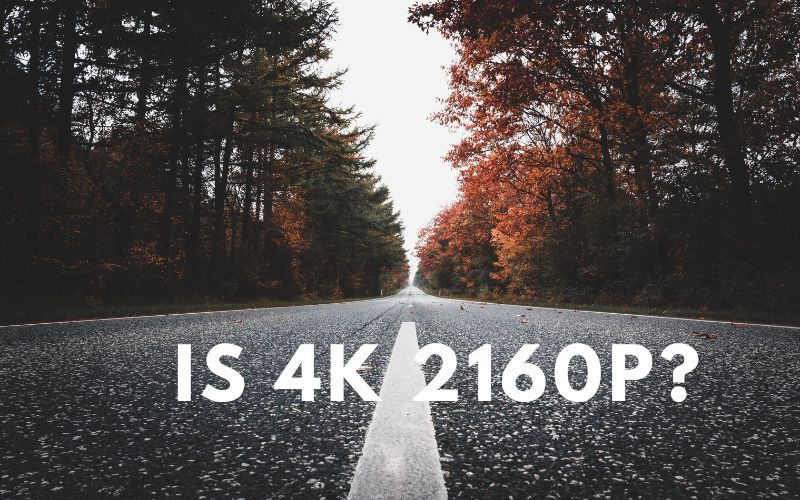Is 4K 2160p? The Truth You Need to Know
 Are you surfing the Internet to find is 4K 2160p? Then, stop your search and read on as our article today will completely focus on this topic.
Are you surfing the Internet to find is 4K 2160p? Then, stop your search and read on as our article today will completely focus on this topic.
A Short answer to this question: they are not the same. 4K resolution denotes a display standard with around 4,000 horizontal pixels, offering enhanced visual quality. On the other hand, "2160p" specifies a vertical resolution of 2160 pixels within this standard. In the context of 4K, it typically signifies a resolution of 4096 x 2160 pixels, while 2160p consistently indicates 3840 x 2160 pixels.
We'll discuss more details to help you understand what's the difference between 4K and 2160p, and provide a comprehensive understanding of their technical specifications.
Part 1: What is 4K Resolution?
Before we dive into the difference between 4K and 2160p, let's understand what is 4k resolution first.
4K resolution, also known as Ultra High Definition (UHD), refers to a display resolution that is approximately 4,000 pixels wide. Compared to previous standard high-definition (HD) resolutions, providing 4 times the resolution than HD videos, which allows more detailed footage.
Bonus: The Best 4K Webcam for Video Recording/Live Streaming
As you already know what's 4K resolution, do you want to try this high-resolution webcam to enhance your videos? You are in the right place as we reveal the OBSBOT Tiny 2 4K webcam.
Its advanced AI tracking capabilities and impressive low-light performance made it a popular choice among live-streaming lovers. The PTZ webcam's innovative features, like gesture and voice control, set it apart from other, even more expensive webcam brands. Since its release, the OBSBOT Tiny 2 has earned positive reviews for its exceptional video quality and effortless usage. It is a top contender for those seeking a high-quality webcam for their streaming needs.
Here's a List of the Features of the OBSBOT Tiny 2:
- 4K Resolution: The OBSBOT Tiny 2 features ultra-large 1/1.5'' CMOS, and offers stunning 4K resolution, ensuring exceptional clarity and detail in your live streaming content.
- AI Tracking: Utilizing advanced algorithms, the OBSBOT Tiny 2 can track your movements in real-time, keeping you centered in the frame as you move around. This feature is perfect for live streaming, continuously focusing on you.
- Low-Light Performance: The advanced image sensor and low-light correction technology of the OBSBOT Tiny 2 deliver impressive performance in dimly lit environments. Your video remains clear and vibrant, ensuring high-quality streaming even in challenging lighting conditions.
- Voice Control: The OBSBOT Tiny 2 features a unique Voice Control capability, allowing you to control the webcam using voice commands. This hands-free functionality lets you adjust settings, start/stop recording, zoom in/out, or switch between different positions, providing a genuinely effortless streaming experience.
- Gesture Control: With built-in gesture control, you can easily adjust settings and activate features without physical buttons or a separate remote. This hands-free control adds convenience and fluidity to your live-streaming experience.
- Compatibility and Connectivity: The OBSBOT Tiny 2 is compatible with popular streaming platforms such as OBS Studio, Twitch, YouTube Live, and more. It connects via USB, providing a reliable and hassle-free connection to your computer or streaming setup.
Part 2: What Is 2160p?
Let us first understand what is 2160p that we are referring to in this article.
Well, 2160p refers to a display resolution commonly associated with high-definition video. It signifies the number of vertical lines in a video frame, with 2160 lines.
In practical terms, 2160p represents a resolution of 3840x2160 pixels, often called 4K Ultra HD (UHD). This resolution provides incredibly sharp and detailed images, offering four times the clarity of Full HD. 2160p is used in various devices, including televisions, computer monitors, and projectors, to deliver stunning visuals with lifelike details. It has become the standard for high-quality video content, enhancing our viewing experiences and allowing us to see images and videos with exceptional clarity and precision.
Part 3: Is 4k 2160p? Why Is It Called 4K Instead of 2160p?
Now we are back to the fundamental question, is 4k 2160p? Let me explain in detail.
While 3840x2160 is considered a 4K and 2160p resolution, "4K" and "2160p" cannot always be used interchangeably. The reason behind this lies in the technical specifications and the naming conventions used in the industry.
The term "4K" simply refers to the horizontal resolution of the display, which is approximately 4000 pixels, derived from the rounded value of the horizontal pixel count. It signifies increased detail and clarity compared to previous display resolutions.
On the other hand, "2160p" indicates the vertical resolution of the display, precisely the number of vertical lines or pixels, which is 2160. It represents the height of the display, regardless of the width.
The discrepancy arises because not all 4K resolutions are 2160 pixels tall, and not all 2160p resolutions have a width of approximately 4000 pixels. The term "4K" has become more popular and widely used as it emphasizes increased resolution and clearly indicates enhanced visual quality.
Hence, while the 2160p resolution is 4K, it is essential to understand that "4K" and "2160p" focus on different aspects of the display resolution. "4K" emphasizes the horizontal resolution, while "2160p" highlights the vertical resolution.
Part 4: 4K VS. 2160p: What's the difference?
Let us go through a detailed table to understand is 2160p equal to 4k in simple terms:
| Aspect | 4K | 2160p |
| Resolution | Approximately 4000 pixels wide | 2160 pixels tall |
| Pixel Count | Varies (e.g., 3840x2160, 4096x2160) | Fixed at 3840x2160 |
| Horizontal View | Higher resolution. Sharper and more detailed images | Lower resolution. Less detail compared to 4K |
| Vertical View | Greater height. Expansive view | Fixed height. Limits the vertical display capabilities |
| Common Usage | Widespread usage in consumer electronics (TVs, monitors, etc.) | Generally used as a synonym for 4K UHD |
While both 4K and 2160p resolutions share the same number of vertical pixels (2160), the key distinction lies in the horizontal resolution.
4K encompasses a broader range of resolutions, varying from approximately 3840 pixels to 4096 pixels in width. On the other hand, 2160p specifically denotes a fixed resolution of 3840x2160 pixels.
4K resolution provides greater detail and sharper images due to its larger number of horizontal pixels. It has become the standard for consumer electronics, including TVs and monitors, offering an immersive viewing experience.
Meanwhile, 2160p is often used as a synonym for 4K UHD, representing the resolution commonly associated with Ultra HD content.
Important Note:
Not all 4K resolutions are 2160 pixels tall, and not all 2160p resolutions have a width of approximately 4000 pixels. The terms "4K" and "2160p" are for different aspects of the display resolution, the horizontal or vertical pixel count, respectively.
Part 5: 4K VS. 2160p: Is 2160p Better than 4K?

So, is 2160p better than 4k?
No, that is not true. 4K is usually considered and is superior to 2160p in terms of resolution and visual quality.
Here are a Few Reasons Why So:
- Higher Resolution: 4K offers better resolution than 2160p with approximately 4000 pixels horizontally. It provides more detail and clarity that bring forth sharper and lifelike images. The increased pixel density makes viewers' viewing experience more enjoyable.
- Wider Adoption: 4K, as you must be aware has become the standard resolution for consumer electronics, for example, televisions, monitors, and projectors. These are much in use by content providers, streamers, and online gamers. Thus, a larger selection of 4K content is available in the market that supports 4K-enabled devices' instead of 2160p.
- Future-Proofing: Choosing 4 K-enabled technology will last you for decades to come. As the industry continues to embrace higher resolutions and enhanced visual experiences, opting for 4K lets your devices handle upcoming advances in display technology.
- Industry Standard: 4K has become the industry benchmark for higher and clearer resolution. 4K content production has become a norm in filmmaking, professional photography, and videography. This resolution allows for seamless integration with professional workflows and ensures the highest quality in content creation.
Thus, as we understand, while 2160p is a good resolution and is sometimes a synonym for 4K UHD, it does not provide the same level of detail and visual fidelity as an accurate 4K resolution. Therefore, opting for 4K instead of 2160p would result in a superior viewing experience and future-proof your devices for upcoming advancements in display technology.
Part 6: FAQs about Is 4K 2160P
1. Is 2160p the same as 4K?
In consumer media, particularly televisions and monitors, 2160p is marketed as 4K UHD (Ultra High Definition), meaning 3840x2160 pixels. However, true 4K resolution uses 4096x2160, which has higher pixels.
2. Why isn't 4K called 2160?
The term "4K" originates from the film industry, where resolutions are typically described by the number of horizontal pixels. In cinema, true 4K refers to 4096 x 2160 pixels. It's called 4K because it represents approximately 4000 pixels across the horizontal axis. Consumer 4K UHD, which is 3840 x 2160, adopted the "4K" label for marketing purposes, aligning it with this cinematic term.
3. Is 2160p a 2K?
No, 2160p is not considered 2K. 2K refers to a resolution standard with 2048 x 1080 pixels, mostly used in digital cinema. 2160p, with resolutions of 3840 x 2160, is significantly higher and categorized as 4K UHD.
4. Is 2160 4K or 8K?
2160p is associated with 4K, not 8K. 4K UHD has a resolution of 3840 x 2160 pixels, while 8K UHD doubles both dimensions, resulting in a resolution of 7680 x 4320 pixels.
5. Is 2160p the best resolution?
While 2160p (4K) offers excellent picture clarity and detail, especially for large displays, whether it is the "best" depends on context, such as screen size, viewing distance, and content availability. Currently, 8K resolutions, offering even higher detail, are emerging, but 4K remains a popular standard for most consumers.
6. What comes after 2160p?
After 2160p (4K), the next resolution tier is typically 8K UHD, which offers a resolution of 7680 x 4320 pixels. 8K provides even more detail and clarity, though its adoption is still growing as more content becomes available and the technology becomes more accessible.
Conclusion
Finally, here we are at the end of our article on is 4k 2160p. We hope you understand the fundamental and technical differences between both resolutions and why 4k is better than 2160p.
We also laid down aspects of what is 2160p in detail and is 2160p good for standard viewers. With this knowledge, you can now distinguish between both and make better decisions for your content creation needs.
Lastly, if you want exceptional results from your live stream on Facebook, Instagram, YouTube, TikTok, etc., use the new OBSBOT Tiny 2 PTZ web camera and its 4K resolution features.















